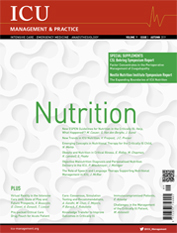Volume 19 - Issue 3, 2019
- ICU
- 26/09/2019
Change content default value
READ MORE
The critically ill patient is often unable to feed by mouth. This condition, in some patients, can range from days to months. It is imperative that these patients receive macronutrients either through enteral or parenteral nutrition. If they don't, there is a risk of an energy deficit that could lead to loss of lean body mass and subsequently, other...
READ MOREBaxter launches a new parenteral nutrition formulation designed to meet the need for higher protein provision in Europe and signs a global partnership with COSMED to commercialise Q-NRG+, a metabolic monitoring device that utilises indirect calorimetry technology. Malnutrition in the ICU Around 20 to 50% of hospital patients, including those...
READ MOREPrudent strategies to optimise nutrition for the critically ill child, improving long-term outcomes, and preserving quality of life. Introduction Optimal delivery of nutrients to the critically ill patient might prevent nutritional deterioration and expedite recovery. Prospective cohort studies have demonstrated the independent association...
READ MOREThe role of nutrition in obese critically ill patients and an overview of the clinical guidelines for nutrition provision in this patient population. Introduction The World Health Organization defines obesity as an excess of abdominal fat that poses an increased risk to health. Characterised by a body mass index (BMI) ≥30 kg/m2, obesity...
READ MOREPoor ICU nutrition delivery remains a challenge worldwide. Objective malnutrition diagnosis and personalisation of nutrition delivery may be one way of addressing this problem. Modern, and increasingly expensive ICU care now allows prolonged survival from illness and injury by providing life-sustaining support for extended periods of time,...
READ MOREInterview with Massimo Antonelli, Professor of Intensive Care and Anaesthesiology, Università Cattolica del Sacro Cuore, Rome, Italy Massimo Antonelli is a Professor of Intensive Care and Anesthesiology at the Università Cattolica del Sacro Cuore, Rome, Italy. He serves as the Director of the Dept. of Anesthesiology and Intensive Care and Emergency...
READ MOREOCTOBER 10-12 8th Annual Johns Hopkins Critical Care Rehabilitation Conference Baltimore, USA 12-16 EUSEM 2019: 13th European Emergency Medicine Congress Prague, Czech Republic 14-18 World Congress of Intensive Care 2019 Melbourne, Australia 15-16 ESA Focus Meeting on Perioperative Medicine 2019: Mother and child Rome, Italy...
READ MOREThe Muscle UK Critical Care program was set up 10 years ago and focused on the association between muscle and skeletal muscle wasting to weakness to clinical outcome. There are a total of five pivotal trials, including Bernhard Jonghe et al. 1 and Herridge M. 2 that looked at skeletal muscle weakness and its impact on patients. In the Herridge study,...
READ MOREMonitoring nutrition in the ICU is significantly different from monitoring other activities. For example, if we look at haemodynamics, it is pretty easy. We can monitor blood pressure, cardiac output etc. We can deliver a drug and look at its effect to see if it works or not, and, if it doesn’t, we can simply change the drug. These are simple activities...
READ MORE